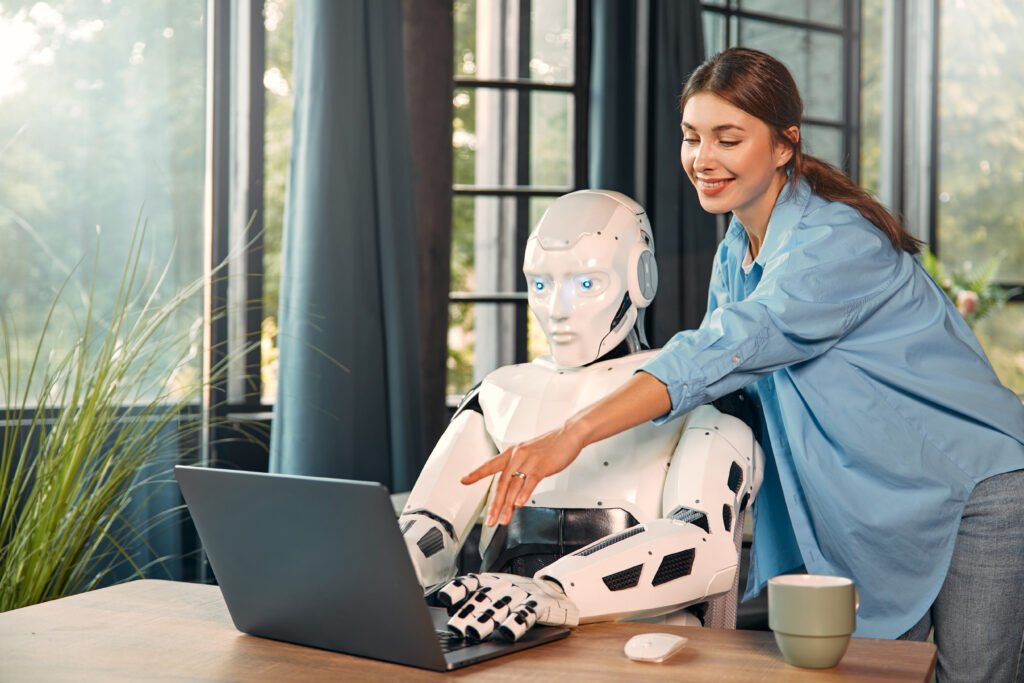AI is drastically changing modern web design through automation, machine learning, and real-time personalization. For instance, AI tools can handle tasks like image optimization and code generation, which streamlines workflow and boosts productivity. According to a 2021 article in Forbes, these tools can help a forward-thinking web design agency focus more on creativity rather than technical chores.
Machine learning algorithms also play a significant role in analyzing user behavior and predicting preferences. This allows websites to deliver personalized content, which can improve user retention rates. A study published in the Journal of Web Engineering found that personalized content can increase user engagement by up to 20%.
AI-powered adaptive and responsive design elements ensure seamless user experiences across different devices. This is crucial because, as Statista reports, over 50% of global web traffic comes from mobile devices. By automating these elements, AI frees up designers to push creative boundaries and innovate.
Overall, these advancements in AI mean that web design can not only meet but also anticipate user needs, paving the way for next-level engagement and satisfaction. Dive into the transformative techniques and strategies that are shaping the future of the industry.
AI Tools in Web Design
In today’s web design landscape, AI tools are revolutionizing the field by automating repetitive tasks like image optimization and code generation. This significantly boosts efficiency, allowing designers to focus more on the creative and complex aspects of their projects.
Leveraging advanced machine learning algorithms, AI tools analyze user behavior and generate personalized content automatically. This not only streamlines workflows but also ensures that every element of a website is optimized for user engagement.
Machine learning algorithms delve deep into user behavior analysis, identifying patterns and preferences that might otherwise go unnoticed. This data-driven approach enables the creation of adaptive and responsive websites tailored to individual users.
For instance, according to a 2021 report by McKinsey, companies that leverage AI for user personalization can see up to a 20% increase in customer satisfaction and engagement. Your design process benefits from AI’s ability to suggest improvements based on real-time user interactions, ensuring that your website remains dynamic and relevant.
Moreover, AI tools facilitate personalized content delivery, enhancing the user experience by catering to specific interests and behaviors. By automating these aspects, you can focus on strategic design elements that drive user engagement and satisfaction.
The New York Times reported that personalized content can lead to a 15% boost in user retention rates. Ultimately, AI tools have become indispensable in modern web design, providing insights and efficiencies needed to stay ahead in a competitive digital landscape.
Enhancing Creativity
Leveraging AI tools not only automates mundane tasks but also empowers designers to push creative boundaries with intelligent suggestions for layouts, color schemes, and content placement.
Research indicates that AI algorithms can analyze vast amounts of user behavior data, predicting design elements that resonate most with your audience. This predictive capacity enhances creativity by enabling the generation of dynamic, visually appealing designs grounded in data-driven insights.
AI tools offer advanced strategies for crafting personalized experiences by making real-time adjustments based on user interactions. For instance, AI-powered design platforms can modify color schemes according to the time of day or user preferences, creating a more engaging and personalized website experience. This approach not only makes your designs more visually appealing but also ensures they’re contextually relevant.
According to major media outlets like TechCrunch, such real-time personalization can significantly boost user engagement and satisfaction.
Moreover, the automation of repetitive tasks such as image resizing or code generation by AI frees up valuable time. This allows designers to focus on innovative concepts and more sophisticated visual storytelling.
Historical evidence from the field of web design shows that integrating AI can consistently produce cutting-edge designs that captivate and retain user interest, ultimately pushing the boundaries of what’s possible in modern web design.
Personalized User Experiences
AI’s capability to analyze user behavior in real time enables incredibly personalized website experiences, which can significantly boost engagement and satisfaction. By leveraging advanced machine learning algorithms, you can track user interactions, preferences, and patterns, allowing you to create tailored user journeys that cater to individual needs.
This real-time data analysis lets you dynamically adjust content and layout, making the website feel uniquely crafted for each visitor.
Creating personalized web experiences requires a deep understanding of user preferences. AI tools can sift through vast amounts of data, identifying trends and behaviors that human designers might miss. With this insight, you can deliver content recommendations that really resonate with users, driving higher conversion rates and improving customer retention.
By anticipating and meeting user needs, you not only enhance satisfaction but also foster loyalty.
Advanced strategies in AI-driven personalization include using predictive analytics to forecast user behavior and integrating adaptive design elements that change based on user interactions. According to a report from McKinsey & Company, companies that excel at personalization generate 40% more revenue from those activities than average players.
By aligning your web design with individual user needs, you ensure a seamless and engaging experience, ultimately transforming casual visitors into dedicated users.
Embrace AI’s capabilities to elevate your web design and meet the ever-evolving demands of today’s digital audience.
Streamlining Development
Using machine learning and automation, AI significantly cuts down the time and effort needed for coding, testing, and debugging in web development. Instead of getting stuck manually writing and refining code, AI automates these tasks, freeing you up to concentrate on more strategic aspects.
This automation also handles routine tasks like image resizing and layout adjustments, streamlining your workflow and boosting productivity.
Picture this: AI-driven tools analyze your code in real time, spotting errors and suggesting optimizations. This kind of task optimization not only speeds up development but also ensures accuracy, leading to robust and consistent final products. With AI, the initial design phase becomes faster, allowing you to quickly move from concept to execution.
For more advanced strategies, think about integrating AI capabilities that can test your designs across various platforms and browsers ahead of time. This ensures cross-compatibility and reduces the need for post-launch fixes.
This proactive approach makes web development more efficient, resulting in higher-quality outputs.
Future Trends in AI
You’re about to use AI to tap into predictive design insights, letting you anticipate what users need and streamline their experience.
With real-time personalization techniques, AI will help you create dynamic, highly tailored experiences that adapt instantly to user behavior.
Integrating voice-activated interfaces will revolutionize how we interact with technology, offering seamless, hands-free navigation.

Predictive Design Insights
Leveraging predictive design insights, modern web design taps into the power of machine learning algorithms to anticipate user behavior and create intuitive, personalized experiences. By analyzing vast amounts of data, these algorithms identify patterns and trends, enabling you to make data-driven design decisions that boost user engagement and satisfaction. Predictive design insights help create responsive and personalized websites, adapting in real time to meet the unique needs of each individual user.
Machine learning models enhance user behavior prediction by examining how visitors interact with different website elements. This foresight allows you to design personalized website experiences that resonate with users, thereby increasing conversion rates and customer loyalty. For example, predictive analytics can identify which design elements are most likely to capture a user’s attention or which content will generate the most engagement which is key for high-performing SEO agency strategies.
Incorporating these insights into your design strategy not only streamlines the design process but also ensures your website stays relevant and competitive. By harnessing the power of AI, you can anticipate user needs and preferences, creating a dynamic and adaptive web environment. The future of web design lies in using predictive design insights to build websites that aren’t just visually appealing but also deeply intuitive and user-centric.
For more on how predictive design is shaping the web, check out resources from Wikipedia or major media outlets like Wired or TechCrunch.
Real-time Personalization Techniques
In today’s web design, real-time personalization techniques powered by AI algorithms instantly adapt website content based on user behavior and preferences. By leveraging user data, these advanced strategies enable you to create dynamic and customized experiences that significantly enhance user engagement.
AI algorithms analyze user data in real time to deliver personalized recommendations, tailoring content and offers to individual user preferences. This not only increases user satisfaction but also drives more meaningful interactions on your website.
Here are four crucial techniques you can implement:
- Behavioral Analysis: Track user behavior to predict their needs and adjust website content accordingly. For instance, if a user frequently visits certain pages or lingers on specific types of content, the site can prioritize showing more of that content.
- Dynamic Content Delivery: Use AI to show different content to different users based on their past interactions. Think of how Netflix suggests shows you might like based on what you’ve watched.
- Personalized Product Recommendations: Leverage machine learning to suggest products that align with user preferences and browsing history. Amazon is a prime example of this, often showing products that align closely with what you’ve previously searched for or purchased.
- Adaptive User Interfaces: Modify the layout and elements of the website in real-time to suit individual user workflows. For example, Google Search sometimes tailors its interface based on the type of information you’re seeking, like prioritizing news articles for current events.
Voice-Activated Interfaces
Voice-activated interfaces, powered by sophisticated AI algorithms, are revolutionizing how users interact with websites by enabling hands-free navigation and instant responses. These interfaces significantly boost user engagement by providing seamless interactions that match the growing consumer preference for intuitive technology. With voice search usage projected to account for 50% of all searches (source: ComScore), integrating voice-activated interfaces into your web design strategy isn’t just innovative—it’s essential.
AI-driven voice chatbots are another key component, offering real-time responses that keep users engaged and satisfied. These chatbots use natural language processing (NLP) to understand and respond to user queries, creating a more interactive and personalized browsing experience. Your website can cater to users who prefer hands-free browsing, enhancing both accessibility and user satisfaction.
To stay competitive, incorporating voice-activated interfaces into your web design is crucial. Not only does this meet current consumer demands, but it also positions your business at the forefront of future technological trends. By embracing these AI-driven advancements, you ensure that your website offers the most efficient and engaging user experience possible, driving higher engagement and retention rates.

Claire Marshall is the dedicated Editor-in-Chief of NewNoted, with a lifelong passion for journalism and a commitment to transparent and responsible reporting. Hailing from Charleston, South Carolina, she brings a love for storytelling, a devotion to ethics, and a deep appreciation for diverse perspectives to her role at the helm of NewNoted.



